The Indian stock market has entered a correction phase, with the Sensex and Nifty 50 indices falling 10% from their record highs in September 2024. This decline, marked by significant foreign fund outflows and weaker-than-expected corporate earnings, signals growing concerns over market valuations and economic headwinds.
Record Highs to Correction Mode: The Journey
In September 2024, the BSE Sensex and NSE Nifty 50 reached their all-time highs, hitting 85,978.25 and 26,277.35, respectively. However, by late November, the Sensex has dropped 8,397.94 points, or 9.76%, to close at 77,580.3. Similarly, the Nifty has fallen 2,744.65 points, or 10.44%, to end at 23,532.7. This marks the sixth weekly loss in the past seven weeks for Indian equities.
Twelve of the thirteen major sectors logged weekly losses, with small-cap and mid-cap indices underperforming, dropping 4.6% and 4.1% respectively. The Nifty also closed below its 200-day moving average for the first time since April 2023, further confirming the market’s bearish momentum.
Reasons Behind the Market Dip
The correction phase can be attributed to several factors:
- Foreign Fund Outflows: Foreign Institutional Investors (FIIs) have withdrawn nearly ₹22,156 crore so far in November and $15 billion over the last 33 sessions.
- High Inflation: Retail inflation surged to a 14-month high in October due to rising food prices, delaying potential interest rate cuts by the Reserve Bank of India.
- Disappointing Corporate Earnings: Weaker-than-expected quarterly results have dampened investor sentiment.
- Stretched Valuations: Overvalued stocks have led to cautious market activity.
- Global Concerns: Rising geopolitical tensions and fears of a global economic slowdown have added to the uncertainty.
According to Vishnu Kant Upadhyay, AVP – Research and Advisory at Master Capital Services Ltd., “Selling pressure was widespread, with the banking sector facing the steepest losses, driven by expectations that the Reserve Bank of India may further delay interest rate cuts due to persistently high inflation, further dampening market sentiment.”
Trading Strategies During Correction
Amid this volatile environment, traders and investors are advised to adopt a cautious approach:
- Focus on Fundamentals: Invest in companies with strong fundamentals and robust balance sheets. Avoid speculative stocks during a downturn.
- Diversify Portfolio: Reduce exposure to high-risk sectors and diversify across asset classes to mitigate risk.
- Monitor Macroeconomic Indicators: Keep an eye on inflation data, RBI’s policy decisions, and global market trends.
- Avoid Panic Selling: Market corrections are temporary. Investors should avoid making hasty decisions driven by fear.
- Leverage Defensive Sectors: Consider investing in defensive sectors like FMCG, utilities, and healthcare, which tend to perform better during market downturns.
What Lies Ahead for Indian Markets?
Market experts believe that the correction phase could continue in the short term, especially if inflation remains high and foreign outflows persist. However, long-term investors can use this opportunity to buy quality stocks at discounted prices. Historical trends show that corrections often pave the way for sustained market recoveries.
The focus will now shift to upcoming corporate earnings reports, global economic developments, and policy measures by the RBI to manage inflation and stabilize the rupee. “The market’s trajectory will largely depend on how these factors evolve in the coming months,” experts note.
Conclusion
The recent decline in Sensex and Nifty underscores the importance of a balanced investment strategy during market corrections. While short-term volatility may persist, opportunities abound for those who maintain a long-term perspective. Stay informed, remain patient, and leverage professional advice to navigate these challenging times effectively.

